Spanish-Language News Consumption and Latino Reactions to COVID-19
Abstract
:1. Introduction
1.1. Media Use and Source Credibility
1.2. Source Credibility and Health Behavior
2. Materials and Methods
3. Results
4. Discussion
5. Conclusions
Author Contributions
Funding
Institutional Review Board Statement
Informed Consent Statement
Data Availability Statement
Acknowledgments
Conflicts of Interest
Appendix A. Variable Construction and Summary Statistics
| Variable | Observations | Mean | Std. Dev. | Min | Max |
|---|---|---|---|---|---|
| Trust in EL journalist | 601 | 5.418 | 3.108 | 0 | 10 |
| Trust in SL journalist | 599 | 5.701 | 3.130 | 0 | 10 |
| Stopping the spread of COVID-19 | 585 | 3.303 | 0.800 | 1 | 4 |
| Location of nearest testing site | 582 | 2.826 | 1.036 | 1 | 4 |
| Collective health | 1200 | 0.804 | 0.397 | 0 | 1 |
| English-language news consumption | 1200 | 2.215 | 0.916 | 0 | 3 |
| Spanish-language news consumption | 1200 | 1.942 | 1.042 | 0 | 3 |
| COVID-19 news consumption | 1200 | 4.165 | 1.041 | 0 | 5 |
| Age | 1200 | 2.222 | 1.012 | 1 | 4 |
| Education | 1200 | 3.003 | 1.539 | 1 | 5 |
| Female | 1200 | 0.520 | 0.500 | 0 | 1 |
| US-born | 1200 | 0.600 | 0.490 | 0 | 1 |
| SL survey | 1200 | 0.414 | 0.493 | 0 | 1 |
| Partisanship | 1200 | 1.857 | 0.795 | 1 | 3 |
| Cuban | 1200 | 0.083 | 0.277 | 0 | 1 |
| Public risk perception | 1200 | 0.438 | 0.496 | 0 | 1 |
References
- Anwar, A.; Malik, M.; Raees, V.; Anwar, A. Role of Mass Media and Public Health Communications in the COVID-19 Pandemic. Cureus 2020, 12, e10453. [Google Scholar] [CrossRef]
- Hameleers, M.; van der Meer, T.G.; Brosius, A. Feeling “disinformed” lowers compliance with COVID-19 guidelines: Evidence from the US, UK, Netherlands and Germany. Harv. Kennedy Sch. Misinf. Rev. 2020, 1. [Google Scholar] [CrossRef]
- Pazzanese, C. The Harvard Gazette. Battling the ‘Pandemic of Misinformation’. Available online: https://news.harvard.edu/gazette/story/2020/05/social-media-used-to-spread-create-covid-19-falsehoods/ (accessed on 8 May 2020).
- Lin, L.; Savoia, E.; Agboola, F.; Viswanath, K. What have we learned about communication inequalities during the H1N1 pandemic: A systematic review of the literature. BMC Public Health 2014, 14, 484. [Google Scholar] [CrossRef] [PubMed] [Green Version]
- Vargas, E.D.; Viridiana, L.B. Latino parents’ links to deportees are associated with developmental disorders in their children. J. Community Psychol. 2019, 47, 1151–1168. [Google Scholar] [CrossRef]
- Viswanath, K.; Ackerson, L.K. Race, ethnicity, language, social class, and health communication inequalities: A nationally-representative cross-sectional study. PLoS ONE 2011, 6, e14550. [Google Scholar] [CrossRef] [PubMed] [Green Version]
- Taha, S.A.; Matheson, K.; Anisman, H. The 2009 H1N1 influenza pandemic: The role of threat, coping, and media trust on vaccination intentions in Canada. J. Health Commun. 2013, 18, 278–290. [Google Scholar] [CrossRef] [PubMed]
- Schudson, M. The Fall, Rise, and Fall of Media Trust. Columbia Journalism Review, Winter. 2019. Available online: https://www.cjr.org/special_report/the-fall-rise-and-fall-of-media-trust.php (accessed on 15 January 2021).
- Abrajano, M.; Panagopoulos, C. Does language matter? The impact of Spanish versus English-language GOTV efforts on Latino turnout. Am. Politics Res. 2011, 39, 643–663. [Google Scholar] [CrossRef]
- Abrajano, M.; Singh, S. Examining the link between issue attitudes and news source: The case of Latinos and immigration reform. Political Behav. 2009, 31, 1–30. [Google Scholar] [CrossRef]
- Clayman, M.L.; Manganello, J.A.; Viswanath, K.; Hesse, B.W.; Arora, N.K. Providing health messages to Hispanics/Latinos: Understanding the importance of language, trust in health information sources, and media use. J. Health Commun. 2010, 15 (Suppl. 3), 252–263. [Google Scholar] [CrossRef]
- Quinn, S.C. Crisis and emergency risk communication in a pandemic: A model for building capacity and resilience of minority communities. Health Promot. Pract. 2008, 9 (Suppl. 4), 18S–25S. [Google Scholar] [CrossRef]
- Centers for Disease Control and Prevention. COVID Data Tracker. 2021. Available online: https://covid.cdc.gov/covid-data-tracker/#cases_casesper100klast7days (accessed on 1 August 2021).
- Lee, S.T.; Basnyat, I. From press release to news: Mapping the framing of the 2009 H1N1 A influenza pandemic. Health Commun. 2013, 28, 119–132. [Google Scholar] [CrossRef] [PubMed]
- Allen, J. New America Media. Ethnic Media Reaching Record Numbers in US. Available online: https://go.shr.lc/3bFmbER (accessed on 8 May 2020).
- Krogstad, J.M.; Stepler, R.; Lopez, M.H. English Proficiency on the Rise among Latinos U.S. Born Driving Language Changes; Pew Research Center: Washington, DC, USA, 2015. [Google Scholar]
- Gomez-Aguinaga, B. One Group, Two Worlds? Latino Perceptions of Policy Salience among Mainstream and Spanish-Language News Consumers. Soc. Sci. Q. 2021, 102, 238–258. [Google Scholar] [CrossRef]
- Abrajano, M.A.; Alvarez, R.M. Assessing the causes and effects of political trust among US Latinos. Am. Politics Res. 2010, 38, 110–141. [Google Scholar] [CrossRef] [Green Version]
- Fletcher, R.; Park, S. The impact of trust in the news media on online news consumption and participation. Digit. J. 2017, 5, 1281–1299. [Google Scholar] [CrossRef]
- Lewis, S.C. Lack of trust in the news media, institutional weakness, and relational journalism as a potential way forward. Journalism 2019, 20, 44–47. [Google Scholar] [CrossRef]
- Fisher, C. What is Meant by ‘Trust’ in News Media? In Trust in Media and Journalism; Springer VS: Wiesbaden, Germany, 2018; pp. 19–38. [Google Scholar]
- Bucy, E.P. Media credibility reconsidered: Synergy effects between on-air and online news. Journal. Mass Commun. Q. 2003, 80, 247–264. [Google Scholar] [CrossRef]
- Williams, A.E. Trust or bust? Questioning the relationship between media trust and news attention. J. Broadcasting Electron. Media 2012, 56, 116–131. [Google Scholar] [CrossRef]
- Eveland, W.P.; Shah, D.V. The impact of individual and interpersonal factors on perceived news media bias. Political Psychol. 2003, 24, 101–117. [Google Scholar] [CrossRef]
- Robinson, M.J.; Kohut, A. Believability and the press. Public Opin. Q. 1988, 52, 174–189. [Google Scholar] [CrossRef]
- Beaudoin, C.E.; Thorson, E. Credibility perceptions of news coverage of ethnic groups: The predictive roles of race and news use. Howard J. Commun. 2005, 16, 33–48. [Google Scholar] [CrossRef]
- Lee, T. Why they don’t trust the media: An examination of factors predicting trust. Am. Behav. Sci. 2010, 54, 8–21. [Google Scholar] [CrossRef]
- Roper, B.W. Public Attitudes toward Television and Other Media in a Time of Change: The 14. Report in a Series by the Roper Organization Inc; Television Information Office: New York, NY, USA, 1985. [Google Scholar]
- Appelman, A.; Sundar, S.S. Measuring message credibility: Construction and validation of an exclusive scale. J. Mass Commun. Q. 2016, 93, 59–79. [Google Scholar] [CrossRef]
- Hallahan, K. No, Virginia, it’s not true what they say about publicity’s “Implied Third-Party Endorsement” effect. Public Relat. Rev. 1999, 25, 331–350. [Google Scholar] [CrossRef]
- Infante, D.A. The construct validity of semantic differential scales for the measurement of source credibility. Commun. Q. 1980, 28, 19–26. [Google Scholar] [CrossRef]
- Andsager, J.L. Perceptions of credibility of male and female syndicated political columnists. J. Q. 1990, 67, 485–491. [Google Scholar] [CrossRef]
- Baiocchi-Wagner, E.A.; Behm-Morawitz, E. Audience perceptions of female sports reporters: A social-identity approach. Int. J. Sport Commun. 2010, 3, 261–274. [Google Scholar] [CrossRef]
- Brann, M.; Himes, K.L. Perceived credibility of male versus female television newscasters. Commun. Res. Rep. 2010, 27, 243–252. [Google Scholar] [CrossRef]
- Aaker, J.L.; Brumbaugh, A.M.; Grier, S.A. Nontarget markets and viewer distinctiveness: The impact of target marketing on advertising. J. Consum. Psychol. 2000, 9, 127–141. [Google Scholar] [CrossRef]
- Desphande, R.; Stayman, D.M. A tale of two cities: Distinctiveness theory and advertising effectiveness. J. Mark. Res. 1994, 31, 57–64. [Google Scholar]
- Forehand, M.R.; Deshpandé, R. What we see makes us who we are: Priming ethnic self-awareness and advertising response. J. Mark. Res. 2001, 38, 336–348. [Google Scholar] [CrossRef]
- Festinger, L. A theory of social comparison processes. Hum. Relat. 1954, 7, 117–140. [Google Scholar] [CrossRef]
- Andsager, J.L.; Mastin, T. Racial and regional differences in readers’ evaluations of the credibility of political columnists by race and sex. Journal. Mass Commun. Q. 2003, 80, 57–72. [Google Scholar] [CrossRef]
- Arana, G. Decades of Failure. Columbia Journalism Review. 2018. Available online: https://www.cjinstitute.org/resources/publications/ (accessed on 15 May 2021).
- American Society of News Editors (ASNE). ASNE’s 2018 Diversity Survey Results Reflect Low Participation but Encouraging Shifts. 2018. Available online: https://members.newsleaders.org/blog_home.asp?display=2537 (accessed on 15 May 2021).
- Jeffres, L.W. Ethnicity and Ethnic Media Use: A Panel Study. Commun. Res. 2000, 27, 496–535. [Google Scholar] [CrossRef]
- Bendixen and Associates. The Ethnic Media in America: The Giant Hidden in Plain Sight. National Public Radio. 2005. Available online: https://legacy.npr.org/documents/2005/jul/ncmfreport.pdf (accessed on 15 May 2021).
- Subervi-Velez, F. The Mass Media and Latino Politics: Studies of US Media Content, Campaign Strategies and Survey Research: 1984–2004; Routledge: London, UK, 2009. [Google Scholar]
- Suro, R. Remembering the American Dream: Hispanic Immigration and National Policy; Brookings Inst Press: Washington, DC, USA, 1994. [Google Scholar]
- Correa, T. Framing Latinas: Hispanic women through the lenses of Spanish-language and English-language news media. Journalism 2010, 11, 425–443. [Google Scholar] [CrossRef]
- Galarce, E.M.; Minsky, S.; Viswanath, K. Socioeconomic status, demographics, beliefs and A (H1N1) vaccine uptake in the United States. Vaccine 2011, 29, 5284–5289. [Google Scholar] [CrossRef] [PubMed]
- Horney, J.A.; Moore, Z.; Davis, M.; MacDonald, P.D. Intent to receive pandemic influenza A (H1N1) vaccine, compliance with social distancing and sources of information in NC, 2009. PLoS ONE 2010, 5, e11226. [Google Scholar] [CrossRef] [PubMed]
- Jung, M.; Lin, L.; Viswanath, K. Associations between health communication behaviors, neighborhood social capital, vaccine knowledge, and parents’ H1N1 vaccination of their children. Vaccine 2013, 31, 4860–4866. [Google Scholar] [CrossRef]
- Lee, C.J. The interplay between media use and interpersonal communication in the context of healthy lifestyle behaviors: Reinforcing or substituting? Mass Commun. Soc. 2009, 13, 48–66. [Google Scholar] [CrossRef]
- Cline, R.J.; Haynes, K.M. Consumer health information seeking on the Internet: The state of the art. Health Educ. Res. 2001, 16, 671–692. [Google Scholar] [CrossRef] [Green Version]
- Kivits, J. Everyday health and the internet: A mediated health perspective on health information seeking. Sociol. Health Illn. 2009, 31, 673–687. [Google Scholar] [CrossRef]
- Andrulis, D.P.; Siddiqui, N.J.; Gantner, J.L. Preparing racially and ethnically diverse communities for public health emergencies. Health Aff. 2007, 26, 1269–1279. [Google Scholar] [CrossRef]
- Spence, P.R.; Lachlan, K.A.; Westerman, D.; Spates, S.A. Where the gates matter less: Ethnicity and perceived source credibility in social media health messages. Howard J. Commun. 2013, 24, 1–16. [Google Scholar] [CrossRef]
- Gomez-Aguinaga, B.; Dominguez, M.S.; Manzano, S. Immigration and Gender as Social Determinants of Mental Health during the COVID-19 Outbreak: The Case of US Latina/os. Int. J. Environ. Res. Public Health 2021, 18, 6065. [Google Scholar] [CrossRef]
- Lin, L.; Jung, M.; McCloud, R.F.; Viswanath, K. Media use and communication inequalities in a public health emergency: A case study of 2009–2010 pandemic influenza A virus subtype H1N1. Public Health Rep. 2014, 129 (Suppl. 4), 49–60. [Google Scholar] [CrossRef]
- Prati, G.; Pietrantoni, L.; Zani, B. Compliance with recommendations for pandemic influenza H1N1 2009: The role of trust and personal beliefs. Health Educ. Res. 2011, 26, 761–769. [Google Scholar] [CrossRef] [PubMed] [Green Version]
- Barreto, M.; Segura, G. SOMOS–COVID-19 Crisis National Latino Survey. Los Angeles, CA. 2020. Available online: https://latinodecisions.com/polls-and-research/somos-covid-19-crisis-national-latino-survey-april-2020/ (accessed on 15 May 2021).
- Catalán-Matamoros, D.; Peñafiel-Saiz, C. How is communication of vaccines in traditional media: A systematic review. Perspect. Public Health 2019, 139, 34–43. [Google Scholar] [CrossRef]
- Toppenberg-Pejcic, D.; Noyes, J.; Allen, T.; Alexander, N.; Vanderford, M.; Gamhewage, G. Emergency risk communication: Lessons learned from a rapid review of recent gray literature on Ebola, Zika, and Yellow Fever. Health Commun. 2019, 34, 437–455. [Google Scholar] [CrossRef]
- Oh, S.H.; Lee, S.Y.; Han, C. The effects of social media use on preventive behaviors during infectious disease outbreaks: The mediating role of self-relevant emotions and public risk perception. Health Commun. 2021, 36, 972–981. [Google Scholar] [CrossRef]
- Gomez-Aguinaga, B.; Sanchez, G.R.; Barreto, M. Importance of State and Local Variation in Black–Brown Attitudes: How Latinos View Blacks and How Blacks Affect Their Views. J. Race Ethn. Politics 2021, 6, 214–252. [Google Scholar] [CrossRef]
- Sanchez, G.R.; Gomez-Aguinaga, B. Latino rejection of the Trump campaign: How Trump’s racialized rhetoric mobilized the Latino electorate as never before. Aztlan A J. Chicano Stud. 2017, 42, 165–181. [Google Scholar]
- Rhemtulla, M.; Brosseau-Liard, P.É.; Savalei, V. When can categorical variables be treated as continuous? A comparison of robust continuous and categorical SEM estimation methods under suboptimal conditions. Psychol. Methods 2012, 17, 354. [Google Scholar] [CrossRef] [PubMed] [Green Version]
- Hainmueller, J.; Hazlett, C. Kernel regularized least squares: Reducing misspecification bias with a flexible and interpretable machine learning approach. Political Anal. 2014, 22, 143–168. [Google Scholar] [CrossRef]
- Hernandez-Vallant, A.; Sanchez, G.; Roybal, C.; Gomez-Aguinaga, B.; Abrams, B.; Daniel, D.K.; Vargas, E.; Pena, J.; Dominguez, M.S. Compliant but Unprotected: Communities of Color Take Greater Action to Prevent the Spread of COVID-19 but Remain at Risk. 2020. Available online: https://iaphs.org/compliant-but-unprotected-communities-of-color-take-greater-action-to-prevent-the-spread-of-covid-19-but-remain-at-risk/?fbclid=IwAR1m0Sv8cJGzyWRlNA8bHT-boYbqUK-6CRfMTLKgZo8RhGGMNPG4CK7Aw6c (accessed on 15 June 2021).
- Kerevel, Y.P. The influence of Spanish-language media on Latino public opinion and group consciousness. Soc. Sci. Q. 2011, 92, 509–534. [Google Scholar] [CrossRef]
- Moran, K.C. Is changing the language enough? The Spanish-language ‘alternative’in the USA. Journalism 2006, 7, 389–405. [Google Scholar] [CrossRef]
- African American Research Collaborative. COVID-19 Vaccine Poll Methodology. 2021. Available online: https://africanamericanresearch.us/covid-poll-methodology/ (accessed on 8 September 2021).
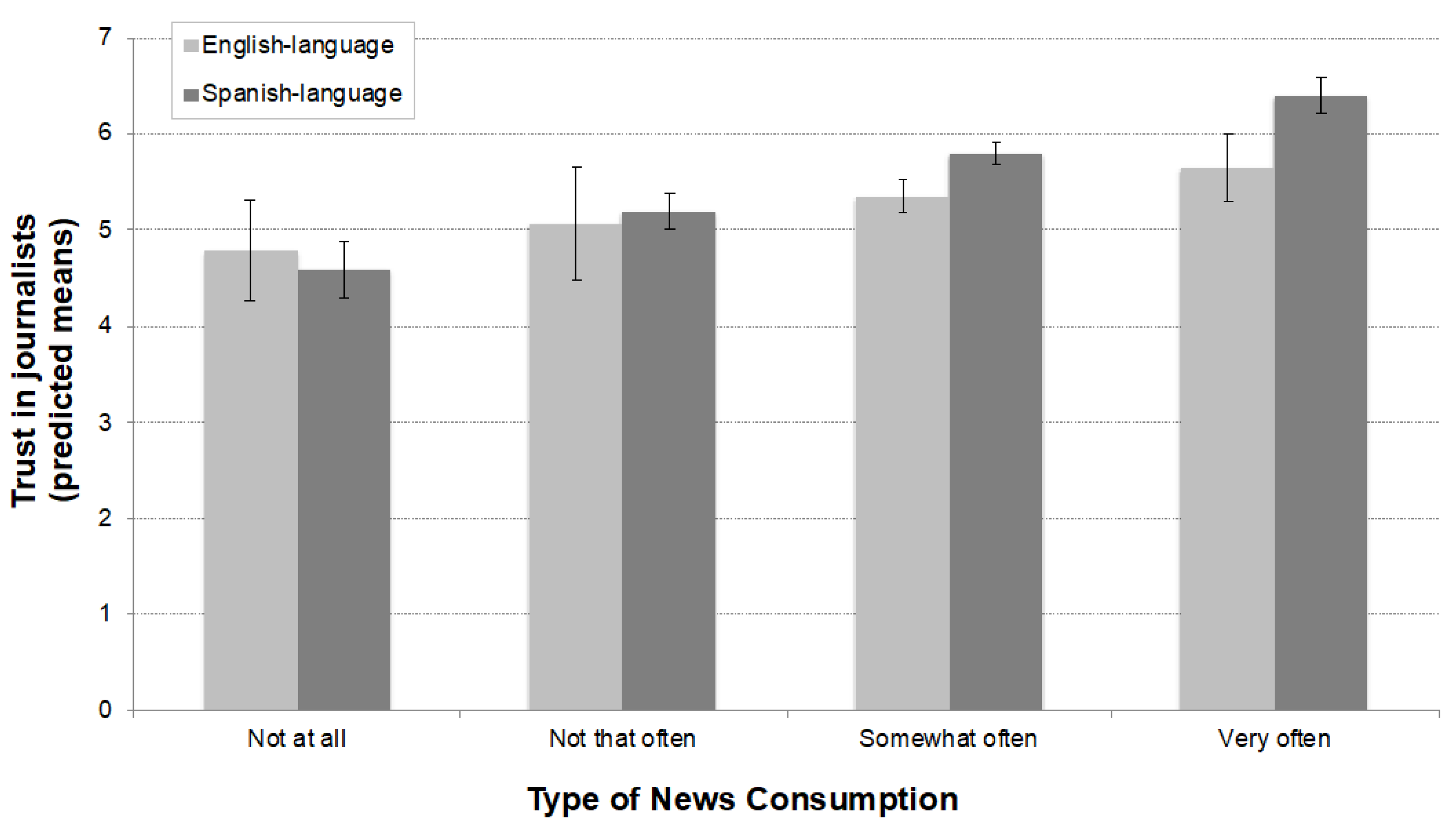

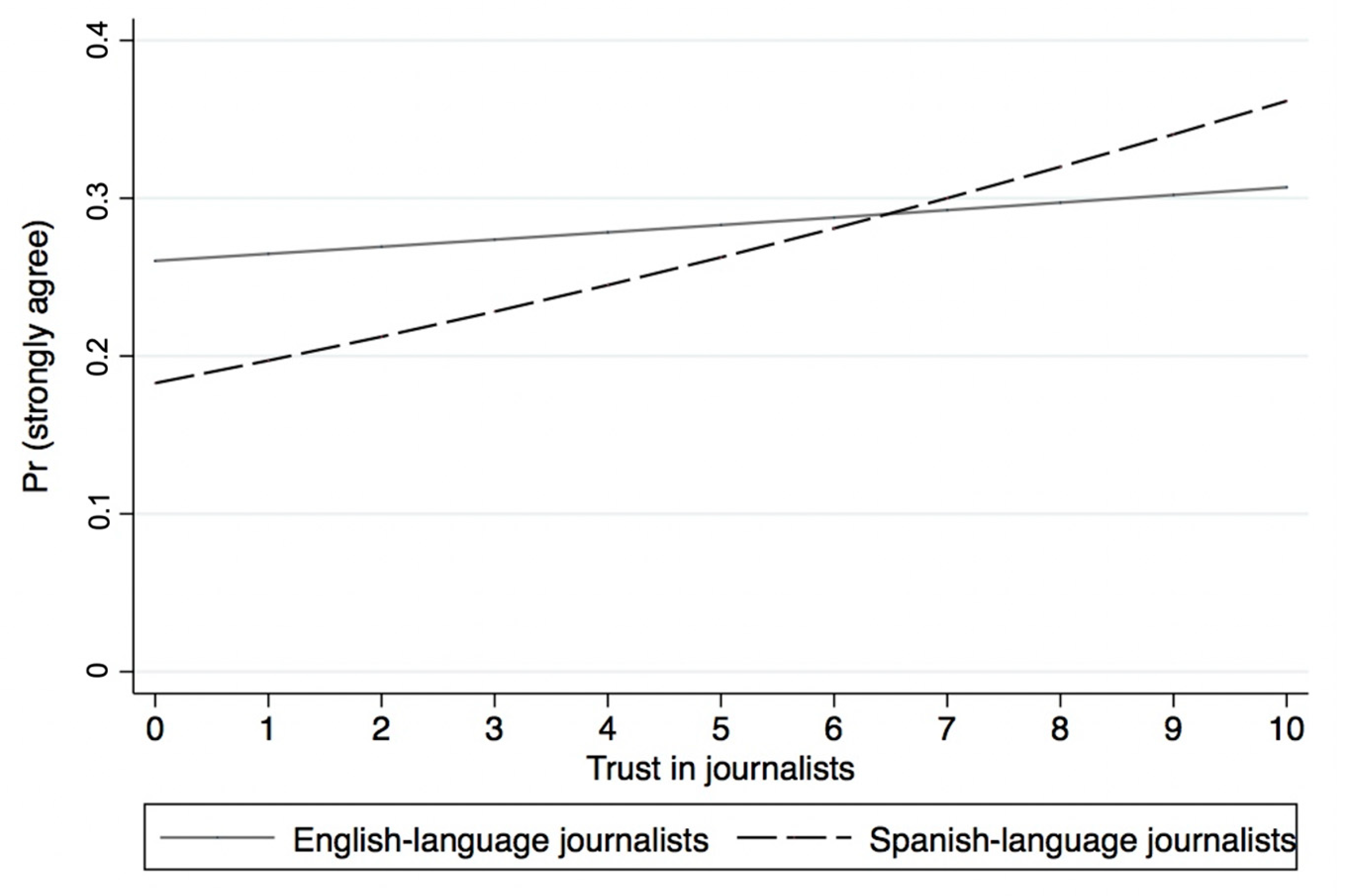
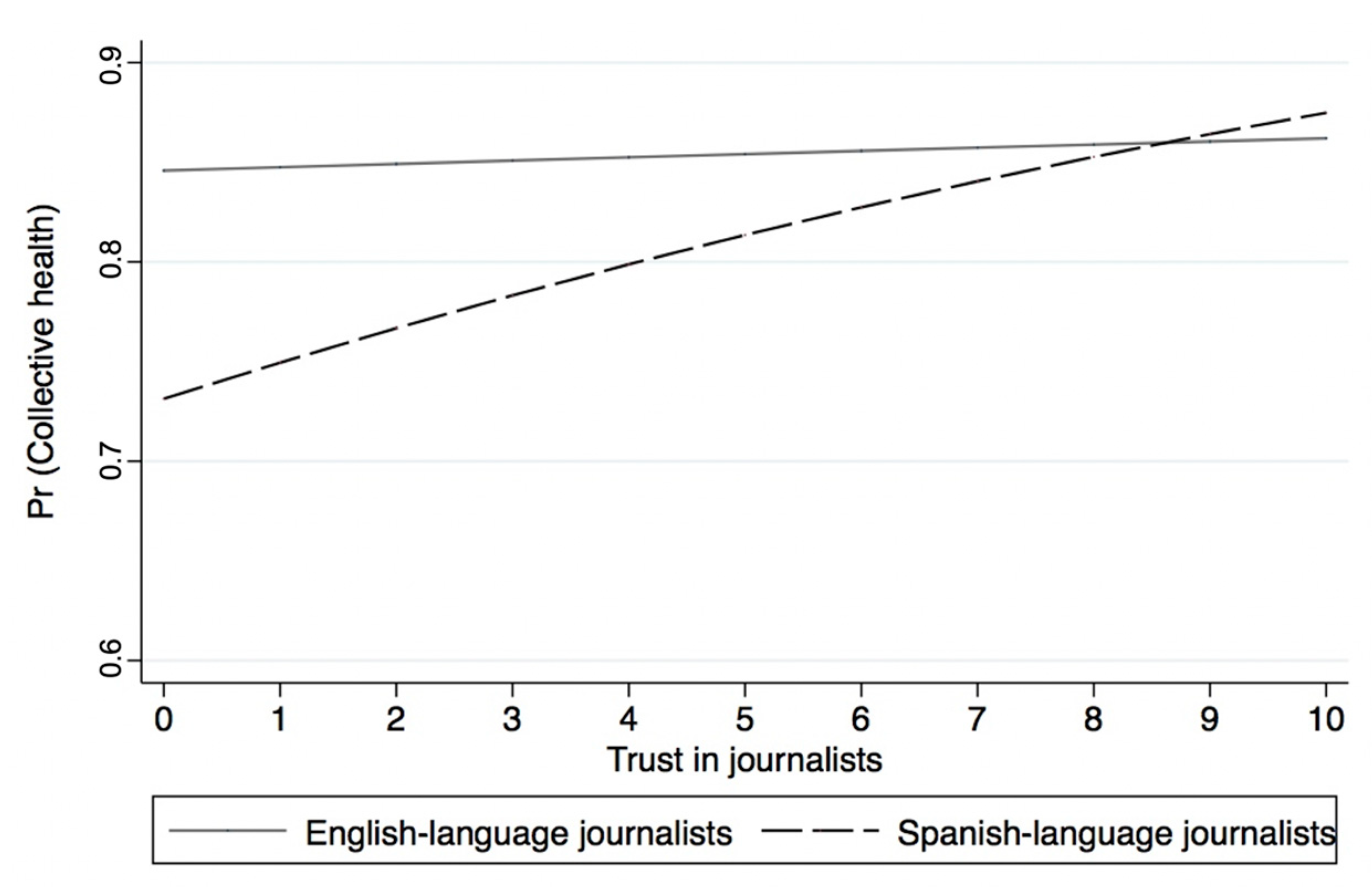
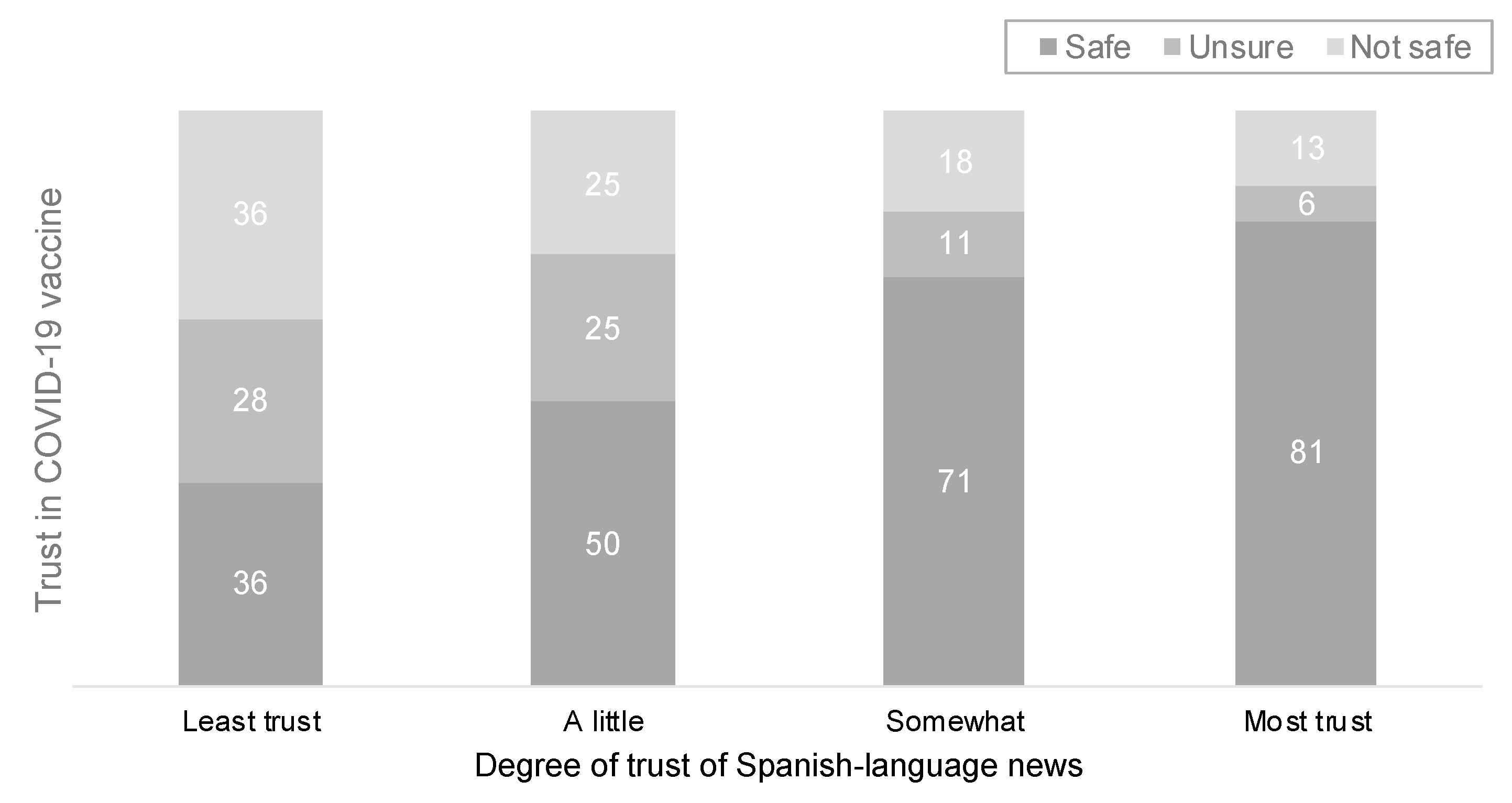
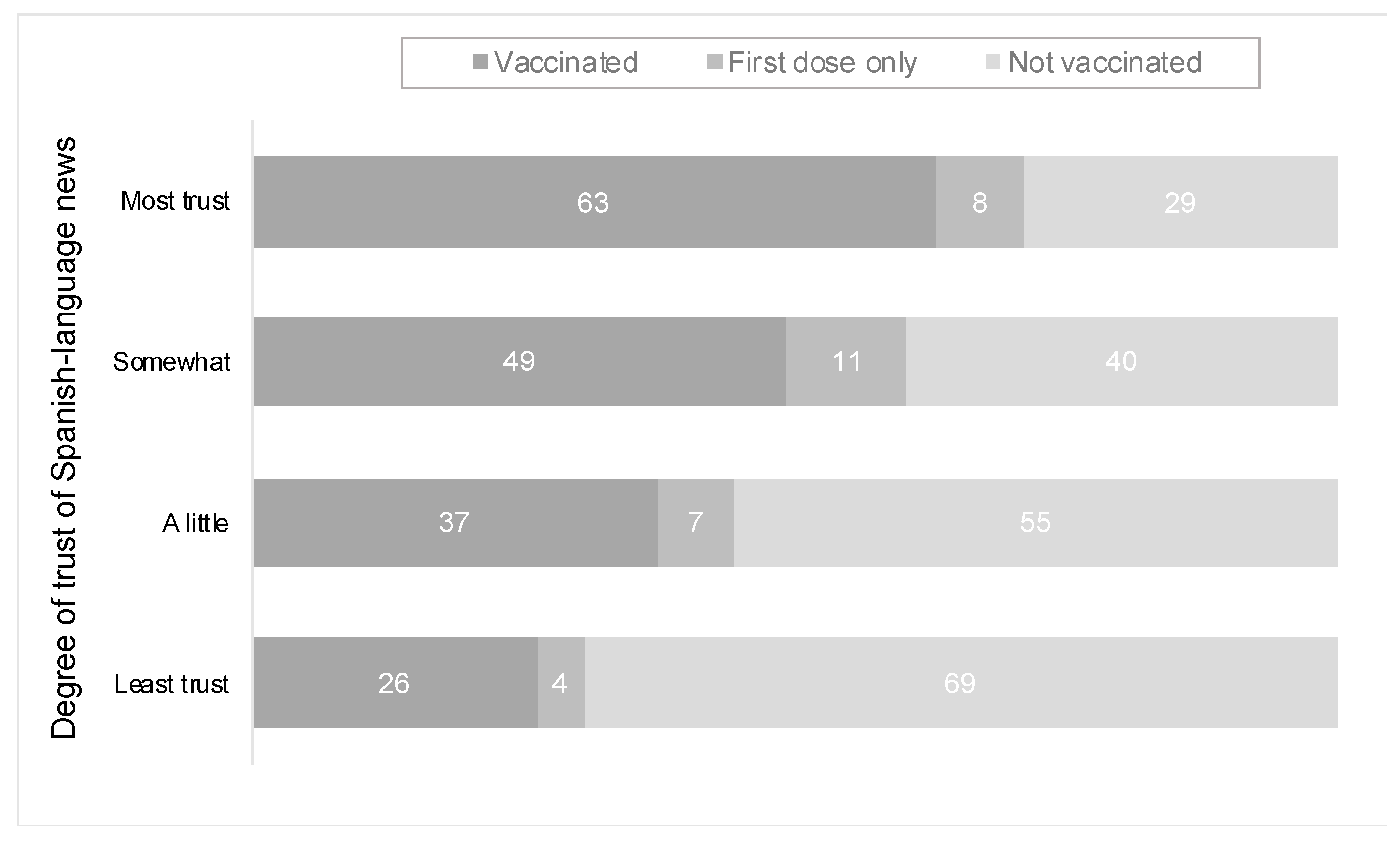
| (1) Trust in English-Language Journalists | (2) Trust in Spanish-Language Journalists | |||
|---|---|---|---|---|
| VARIABLES | Coefficient | SE | Coefficient | SE |
| English-language news consumption | 0.068 | 0.084 | ||
| Spanish-language news consumption | 0.389 *** | 0.084 | ||
| COVID-19 news consumption | 0.305 *** | 0.071 | 0.552 *** | 0.083 |
| Age | 0.223 *** | 0.069 | 0.093 | 0.084 |
| Education | 0.191 *** | 0.049 | 0.109 ** | 0.051 |
| Female | −0.525 ** | 0.232 | 0.097 | 0.259 |
| US-born | 0.011 | 0.242 | 0.022 | 0.276 |
| SL survey | 0.097 | 0.244 | 0.303 | 0.275 |
| Partisanship (Democrat as base) | ||||
| Republican | −0.511 ** | 0.240 | −0.566 ** | 0.273 |
| Independent/Other | −0.746 *** | 0.237 | −0.403 | 0.262 |
| Cuban | 0.230 | 0.318 | −0.255 | 0.381 |
| Public risk perception | 0.192 | 0.233 | −0.391 | 0.261 |
| Observations | 542 | 541 | ||
| What to do to Stop the Spread of COVID-19 | Location of Nearest Testing Site | Collective Health | ||||||||||
|---|---|---|---|---|---|---|---|---|---|---|---|---|
| Model 3 | Model 4 | Model 5 | Model 6 | Model 7 | Model 8 | |||||||
| VARIABLES | Coefficient | S.E. | Coefficient | S.E. | Coefficient | S.E. | Coefficient | S.E. | Coefficient | S.E. | Coefficient | S.E. |
| Trust in EL journalist | 0.085 * | 0.044 | 0.023 | 0.045 | 0.013 | 0.045 | ||||||
| Trust in SL journalist | 0.177 *** | 0.055 | 0.093 * | 0.048 | 0.094 ** | 0.045 | ||||||
| COVID-19 news consumption | 0.264 ** | 0.133 | 0.567 *** | 0.130 | 0.292 ** | 0.115 | 0.403 *** | 0.110 | 0.391 *** | 0.122 | 0.011 | 0.116 |
| Age | 0.246 ** | 0.124 | 0.170 | 0.132 | −0.097 | 0.136 | −0.024 | 0.143 | 0.297 ** | 0.135 | 0.125 | 0.133 |
| Education | −0.080 | 0.087 | 0.030 | 0.090 | 0.040 | 0.091 | −0.025 | 0.092 | 0.037 | 0.090 | 0.168 * | 0.087 |
| Female | 0.040 | 0.262 | 0.312 | 0.276 | −0.494 * | 0.254 | 0.124 | 0.268 | 0.424 | 0.260 | 0.341 | 0.249 |
| US-born | 0.193 | 0.362 | 0.046 | 0.358 | 0.081 | 0.327 | 0.273 | 0.355 | −0.501 | 0.347 | 0.123 | 0.319 |
| SL survey | 0.087 | 0.364 | −0.762 ** | 0.341 | 0.357 | 0.310 | 0.103 | 0.350 | −0.729 ** | 0.337 | 0.229 | 0.351 |
| Partisanship | 0.147 | 0.178 | −0.042 | 0.187 | 0.485 *** | 0.181 | 0.488 *** | 0.155 | −0.591 *** | 0.168 | −0.541 *** | 0.161 |
| Cuban | 0.630 | 0.511 | 0.734 | 0.631 | 0.221 | 0.544 | 0.472 | 0.392 | 1.368 ** | 0.559 | 0.083 | 0.432 |
| Public risk perception | −0.496 * | 0.274 | −0.247 | 0.299 | −0.020 | 0.249 | −0.089 | 0.265 | 0.447 * | 0.259 | 0.553 ** | 0.271 |
| Constant cut1 | −1.142 * | 0.692 | 0.056 | 0.904 | 0.565 | 0.756 | 1.227 * | 0.736 | ||||
| Constant cut2 | 0.082 | 0.718 | 1.403 * | 0.845 | 1.587 ** | 0.754 | 2.461 *** | 0.765 | ||||
| Constant cut3 | 2.272 *** | 0.750 | 3.771 *** | 0.897 | 2.915 *** | 0.783 | 4.179 *** | 0.811 | ||||
| Constant | 0.400 | 0.789 | 0.511 | 0.705 | ||||||||
| Observations | 270 | 264 | 270 | 263 | 542 | 541 | ||||||
Publisher’s Note: MDPI stays neutral with regard to jurisdictional claims in published maps and institutional affiliations. |
© 2021 by the authors. Licensee MDPI, Basel, Switzerland. This article is an open access article distributed under the terms and conditions of the Creative Commons Attribution (CC BY) license (https://creativecommons.org/licenses/by/4.0/).
Share and Cite
Gomez-Aguinaga, B.; Oaxaca, A.L.; Barreto, M.A.; Sanchez, G.R. Spanish-Language News Consumption and Latino Reactions to COVID-19. Int. J. Environ. Res. Public Health 2021, 18, 9629. https://doi.org/10.3390/ijerph18189629
Gomez-Aguinaga B, Oaxaca AL, Barreto MA, Sanchez GR. Spanish-Language News Consumption and Latino Reactions to COVID-19. International Journal of Environmental Research and Public Health. 2021; 18(18):9629. https://doi.org/10.3390/ijerph18189629
Chicago/Turabian StyleGomez-Aguinaga, Barbara, Ana L. Oaxaca, Matt A. Barreto, and Gabriel R. Sanchez. 2021. "Spanish-Language News Consumption and Latino Reactions to COVID-19" International Journal of Environmental Research and Public Health 18, no. 18: 9629. https://doi.org/10.3390/ijerph18189629
APA StyleGomez-Aguinaga, B., Oaxaca, A. L., Barreto, M. A., & Sanchez, G. R. (2021). Spanish-Language News Consumption and Latino Reactions to COVID-19. International Journal of Environmental Research and Public Health, 18(18), 9629. https://doi.org/10.3390/ijerph18189629






